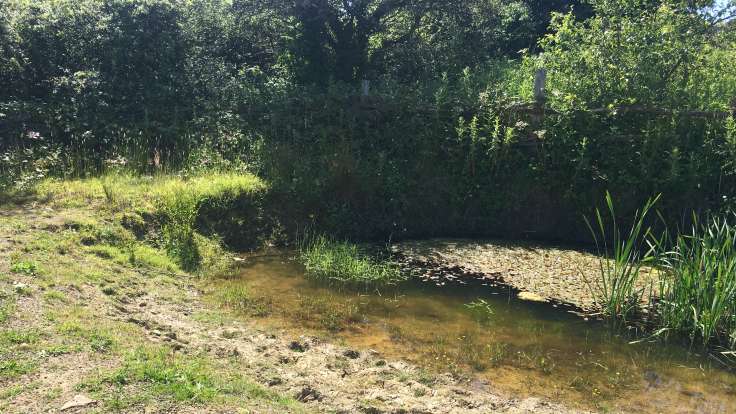
Wildlife pond at Wyndrush Meadows, from a hole dug for clay used in building work
Inspired by Malcolm Berry’s talk, here’s a simple checklist of invaluable features for your wildlife-friendly garden
Inspired by Malcolm Berry’s wildlife gardening talk to Drefach Gardening Club, here is a simple list of features that benefit wildlife in any garden.
- Pond: The number one must-have feature, water is essential for life. It doesn’t have to be big, it doesn’t have to be posh. For ideas, information and inspiration, look at Freshwater Habitats Trust, particularly their Advice Centre. I’m looking to use clay to line our new pond, as I want to cut down on the use of plastic.
- Meadow: Even a small patch of meadow and wildflowers can create so much habitat for all manner of pollinators, predators, mammals, birds etc. I went to see Matt and Vicky at Wyndrush Wild Meadows (that’s one of their wildlife ponds pictured above) and the diversity was fascinating. I have a small “makeshift meadow” in the forest garden, which I scythe once a year to create hay mulch. Malcolm recommended scything just ⅓ of the meadow each year for maximum wildlife.
- Hedges: An unkempt hedge is the ultimate in protection, habitat and food source. Apart from a pond, maybe. Make sure you choose a hedging plant that grows to the desired height and width, to reduce the amount of maintenance. And choose a mixed hedge if you can, with native plants in. For example, hawthorn (Kate Bradbury’s top wildlife plant) can grow to 8 metres tall, whereas the absolutely gorgeous native Guelder Rose grows to 5 metres. Also, grow some evergreen hedges for year round cover. Elaeganus x ebbingei gives you late spring fruit as well, and being evergreen is easy to manage as its growth is slower.
- Mature trees & shrubs: Well, grow a full fledged forest garden! Any tree is brilliant. If you have a smaller garden, you can choose a small rootstock on a fruit tree, or a tree in a big pot, or smaller species, like the Chinquapin instead of the Sweet Chestnut. As for shrubs, I have a soft spot for juneberries and barberries, with plenty of species and cultivars to choose from.
- Log piles: So easy to do, put some logs in a pile. If you have a neat garden, you can tuck your logs out of sight, they’ll still do a great job of providing habitat for a multitude of inverterbrates and amphibians and a food source for everyone.
- Stone piles: The same idea as log piles, put some stones in a pile. Provides a different, less slimy habitat. If you put your stone pile in the sun, you may even see some basking lizards.
- Stone walls: Slightly more involved than a stone pile, but the same idea. Also, a great location for the strangely fashionable (and edible leaved) Wall Pennywort.
- Flowers: Yep, flowers all year round for pollinators and predators. Include some umbellifers for our smaller tongued compatriots. There is a wealth of information online about suitable flowers. Martin Crawford’s book Creating a Forest Garden has a whole appendix devoted to which flowers provide pollen and/or nectar and when.